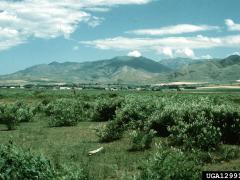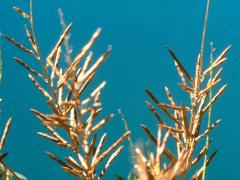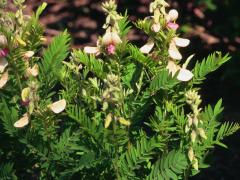Invasive Species: Galega officinalis, Goatsrue
Goatsrue is an invasive plant found in Utah, Pennsylvania, and New York. Goatsrue is listed as a Federal Noxious Weed. It is an herbaceous, perennial plant that can grow up to 6 ft. (1.8 m) in height. Plants are shrubby and multi-stemmed with alternate, pinnately compound leaves. Purple to white, pea-like flowers are arranged in terminal or axillary racemes and are present from June to July. Fruits are short pods with up to nine seeds each. Goatsrue invades wet, disturbed areas such as streambanks, low pastures, and ditches. It can form dense thickets and is toxic to livestock. Goatsrue is native to the Middle East and was first introduced into the United States in Utah in 1891 as forage for livestock.
What are invasive species and why should we be concerned about them?
Taxonomy: Scientific and Common Names for This Species
Fabales > Fabaceae > Galega officinalis L.
Synonym(s): goat’s rue, professor-weed
Galega officinalis – USDA PLANTS Profile
Distribution Maps
Goatsrue – The reported distribution of this invasive species across the United States (Source: Invasive Plant Atlas of the United States)
Up-to-the-minute distribution maps and why they are important
Reporting This Invasive Species
What is the best way and place to report the occurrence of an invasive species?
How to report an invasive species sighting to EDDMapS – Early Detection & Distribution Mapping System
EDDMapS – Report an Invasive Species to EDDMapS
Cooperative Extension Offices – Find your local Cooperative Extension office on this map provided by USDA.
How to Identify
This invasive species can be identified by looking for the characteristics described in the paragraphs that follow.
Plant
It is an herbaceous, perennial plant that can grow up to 6 ft. (1.8 m) in height. Plants are shrubby and multi-stemmed.
 |
 |
| Randy Westbrooks, U.S. Geological Survey, bugwood.org | Steve Dewey, Utah State University, bugwood.org |
Foliage
The leaves are alternate and pinnately compound.
 |
 |
| USDA APHIS PPQ Archive, USDA APHIS PPQ, bugwood.org | USDA APHIS PPQ Archive,USDA APHIS PPQ, bugwood.org |
Flower
Purple to white, pea-like flowers are arranged in terminal or axillary racemes and are present from June to July.
 |
 |
| Steve Dewey, Utah State University, bugwood.org | Steve Dewey, Utah State University, bugwood.org |
Fruit
Fruits are short pods with up to nine seeds each.
 |
 |
| Julia Scher, USDA APHIS PPQ, bugwood.org | Steve Dewey, Utah State University, bugwood.org |
Native species which resemble goatsrue
Tephrosia florida, Florida hoarypea – Images at invasive.org
 |
 |
| Rebekah D. Wallace, University of Georgia, bugwood.org | Rebekah D. Wallace, University of Georgia, bugwood.org |
Tephrosia virginiana, goat’s rue – Images at invasive.org
 |
 |
| Catherine Herms, Ohio State University, bugwood.org | James H. Miller & Ted Bodner, Southern Weed Science Society, bugwood.org |
Additional Images for Goatsrue
Goatsrue – Images at Invasive.org
Additional Information, Biology, Control and Management Resources
Control and management recommendations vary according to individual circumstances. Location, habitat, weather, and a variety of other conditions are factors that help determine the best treatment choice. To find the safest and most effective treatment for your situation, consult your state’s land-grant institution. If you will use chemicals as part of the control process, always refer to the product label.
Unied States Land-Grant University System – Find your land-grant university’s college of agriculture, Cooperative Extension office, or other related partner on this map provided by USDA.
Domestic Programs Pest Evaluation – USDA APHIS PPQ
Noxious weeds of the Federal Noxious Weed Act – USDA APHIS PPQ
Federal Noxious Weed Disseminules of the U.S. – USDA APHIS
Weed of the Week – USDA Forest Service
